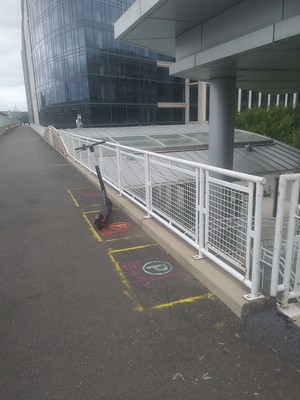Shopping arcade at a transit station in Osaka as an example of the unrealized opportunity at the NoMA Metrorail station in DC
I have mentioned the NHK World channel from Japan, which is broadcast on HDTV and on cable systems in many areas across the US.
One of the programs I try not to miss is "Japan Railway Journal," which is about passenger transit across Japan, ranging from traditional railroad services to streetcars (where they exist) and subways. It's a great way to get best practice ideas.
The latest program is "JR Osaka Loop Line: Developing a Better, More User-Friendly Line," about the 19-station circle line serving Osaka's center.
Among other elements, the program mentioned the ongoing station renovation program. One of the shots is a new "shopping street," what we would call an "arcade" at the Momodani Station.

It reminded me of my piece from 2011, suggesting that a similar kind of shopping arcade could be created alongside the NoMA Metrorail Station in DC, as a distinctive placemaking feature.

Since this photo was taken, to the left of the pylons for the elevated rail line there is now a building, although both the first and second floors (the second floor abuts the Metropolitan Branch Trail) are offset so they are not level with the ground on either floor).
But they could have created an arcade as part of the building project. But there was no way to influence the developer to take such an action.

Nor is WMATA particularly focused on transit and urban design (see "Transit, stations, and placemaking: stations as entrypoints into neighborhoods" and "Transit stations as an element of civic architecture/commerce as an engine of urbanism"). And wrt the NoMA station area specifically, "Public improvement districts ought to be created as part of transit station development process: the east side of NoMA station as an example."
Another example of a similar kind of urban design treatment is the backside of the BANQ library in Montreal, which is set up as "Booksellers Alley."

Although not an arcade, Cecil Court is a booksellers alley in London, and it shows how stores can line a tight space. Of course, in the case of the NoMA Metrorail Station, one side is for the station.

But when DC created the density bonus program for building in NoMA, no urban design requirements were instituted, and they didn't put any energy into figuring out opportunities for distinctive design treatments around the train station or abutting the Metropolitan Branch Trail, the shared use--biking and walking--path alongside the railroad and subway line.
Normally, an arcade in this location wouldn't have the kind of pedestrian traffic necessary for retail to thrive, but by being made into a distinctive place, it could have become a destination.
While I am sure there are many other relevant examples in Tokyo and Osaka, another is the Tenjinbashi-suji Shopping Street arcade also in Osaka, which is not connected to a train station, and is about 2km in length.

Labels: civic architecture, commercial district revitalization planning, integrated public realm framework, station area planning, transit infrastructure, urban design/placemaking



0 Comments:
Post a Comment
<< Home